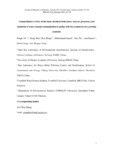JavaScript is disabled for your browser. Some features of this site may not work without it.
| dc.contributor.author | Ali, Waqar | |
| dc.contributor.author | Mao, Kang | |
| dc.contributor.author | Zhang, Hua | |
| dc.contributor.author | Junaid, Muhammad | |
| dc.contributor.author | Xu, Nan | |
| dc.contributor.author | Rasool, Atta | |
| dc.contributor.author | Feng, Xinbin | |
| dc.contributor.author | Yang, Zhugen | |
| dc.date.accessioned | 2020-09-07T10:28:42Z | |
| dc.date.available | 2020-09-07T10:28:42Z | |
| dc.date.issued | 2020-04-21 | |
| dc.identifier.citation | Ali W, Mao K, Zhang H, et al., (2020) Comprehensive review of the basic chemical behaviours, sources, processes, and endpoints of trace element contamination in paddy soil-rice systems in rice-growing countries. Journal of Hazardous Materials, Volume 397, October 2020, Article number 122720 | en_UK |
| dc.identifier.issn | 0304-3894 | |
| dc.identifier.uri | https://doi.org/10.1016/j.jhazmat.2020.122720 | |
| dc.identifier.uri | http://dspace.lib.cranfield.ac.uk/handle/1826/15758 | |
| dc.description.abstract | Rice is the leading staple food for more than half of the world’s population, and approximately 160 million hectares of agricultural area worldwide are under rice cultivation. Therefore, it is essential to fulfil the global demand for rice while maintaining food safety. Rice acts as a sink for potentially toxic metals such as arsenic (As), selenium (Se), cadmium (Cd), lead (Pb), zinc (Zn), manganese (Mn), nickel (Ni), and chromium (Cr) in paddy soil-rice systems due to the natural and anthropogenic sources of these metals that have developed in the last few decades. This review summarizes the sources and basic chemical behaviours of these trace elements in the soil system and their contamination status, uptake, translocation, and accumulation mechanisms in paddy soil-rice systems in major rice-growing countries. Several human health threats are significantly associated with these toxic and potentially toxic metals not only due to their presence in the environment (i.e., the soil, water, and air) but also due to the uptake and translocation of these metals via different transporters. Elevated concentrations of these metals are toxic to plants, animals, and even humans that consume them regularly, and the uniform deposition of metals causes a severe risk of bioaccumulation. Furthermore, the contamination of rice in the global rice trade makes this a critical problem of worldwide concern. Therefore, the global consumption of contaminated rice causes severe human health effects that require rapid action. Finally, this review also summarizes the available management/remediation measures and future research directions for addressing this critical issue. | en_UK |
| dc.language.iso | en | en_UK |
| dc.publisher | Elsevier | en_UK |
| dc.rights | Attribution-NonCommercial-NoDerivatives 4.0 International | * |
| dc.rights.uri | http://creativecommons.org/licenses/by-nc-nd/4.0/ | * |
| dc.subject | Trace metal contaminants | en_UK |
| dc.subject | Paddy soil system | en_UK |
| dc.subject | Health effects | en_UK |
| dc.subject | Transportation mechanisms | en_UK |
| dc.subject | Accumulation | en_UK |
| dc.title | Comprehensive review of the basic chemical behaviours, sources, processes, and endpoints of trace element contamination in paddy soil-rice systems in rice-growing countries | en_UK |
| dc.type | Article | en_UK |
Files in this item
The following license files are associated with this item:
This item appears in the following Collection(s)
-
Staff publications (SWEE) [2825]

